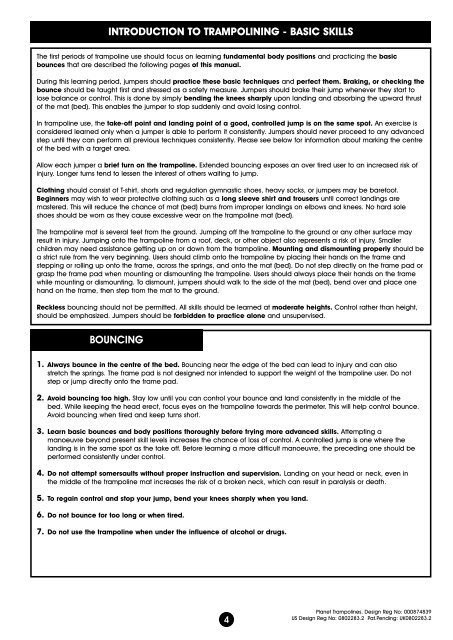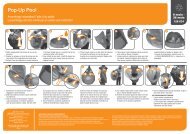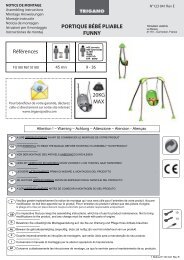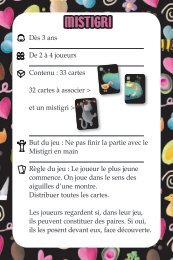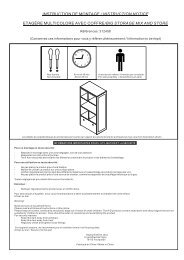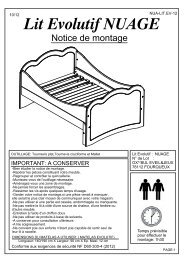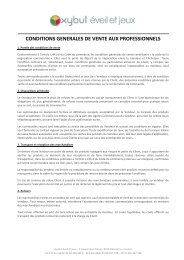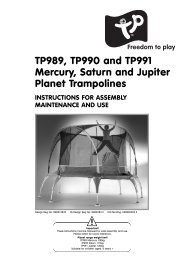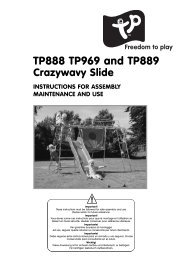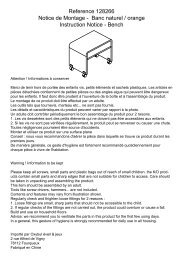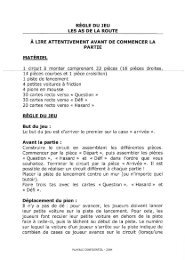TP987 Pluto Planet Trampoline â INSTRUCTIONS ... - Eveil et jeux
TP987 Pluto Planet Trampoline â INSTRUCTIONS ... - Eveil et jeux
TP987 Pluto Planet Trampoline â INSTRUCTIONS ... - Eveil et jeux
Create successful ePaper yourself
Turn your PDF publications into a flip-book with our unique Google optimized e-Paper software.
<strong>TP987</strong> 8ft NGT <strong>Pluto</strong> IN9849 12 08 12/1/09 17:16 Page 4<br />
INTRODUCTION TO TRAMPOLINING - BASIC SKILLS<br />
The first periods of trampoline use should focus on learning fundamental body positions and practicing the basic<br />
bounces that are described the following pages of this manual.<br />
During this learning period, jumpers should practice these basic techniques and perfect them. Braking, or checking the<br />
bounce should be taught first and stressed as a saf<strong>et</strong>y measure. Jumpers should brake their jump whenever they start to<br />
lose balance or control. This is done by simply bending the knees sharply upon landing and absorbing the upward thrust<br />
of the mat (bed). This enables the jumper to stop suddenly and avoid losing control.<br />
In trampoline use, the take-off point and landing point of a good, controlled jump is on the same spot. An exercise is<br />
considered learned only when a jumper is able to perform it consistently. Jumpers should never proceed to any advanced<br />
step until they can perform all previous techniques consistently. Please see below for information about marking the centre<br />
of the bed with a targ<strong>et</strong> area.<br />
Allow each jumper a brief turn on the trampoline. Extended bouncing exposes an over tired user to an increased risk of<br />
injury. Longer turns tend to lessen the interest of others waiting to jump.<br />
Clothing should consist of T-shirt, shorts and regulation gymnastic shoes, heavy socks, or jumpers may be barefoot.<br />
Beginners may wish to wear protective clothing such as a long sleeve shirt and trousers until correct landings are<br />
mastered. This will reduce the chance of mat (bed) burns from improper landings on elbows and knees. No hard sole<br />
shoes should be worn as they cause excessive wear on the trampoline mat (bed).<br />
The trampoline mat is several fe<strong>et</strong> from the ground. Jumping off the trampoline to the ground or any other surface may<br />
result in injury. Jumping onto the trampoline from a roof, deck, or other object also represents a risk of injury. Smaller<br />
children may need assistance g<strong>et</strong>ting up on or down from the trampoline. Mounting and dismounting properly should be<br />
a strict rule from the very beginning. Users should climb onto the trampoline by placing their hands on the frame and<br />
stepping or rolling up onto the frame, across the springs, and onto the mat (bed). Do not step directly on the frame pad or<br />
grasp the frame pad when mounting or dismounting the trampoline. Users should always place their hands on the frame<br />
while mounting or dismounting. To dismount, jumpers should walk to the side of the mat (bed), bend over and place one<br />
hand on the frame, then step from the mat to the ground.<br />
Reckless bouncing should not be permitted. All skills should be learned at moderate heights. Control rather than height,<br />
should be emphasized. Jumpers should be forbidden to practice alone and unsupervised.<br />
BOUNCING<br />
1. Always bounce in the centre of the bed. Bouncing near the edge of the bed can lead to injury and can also<br />
str<strong>et</strong>ch the springs. The frame pad is not designed nor intended to support the weight of the trampoline user. Do not<br />
step or jump directly onto the frame pad.<br />
2. Avoid bouncing too high. Stay low until you can control your bounce and land consistently in the middle of the<br />
bed. While keeping the head erect, focus eyes on the trampoline towards the perim<strong>et</strong>er. This will help control bounce.<br />
Avoid bouncing when tired and keep turns short.<br />
3. Learn basic bounces and body positions thoroughly before trying more advanced skills. Attempting a<br />
manoeuvre beyond present skill levels increases the chance of loss of control. A controlled jump is one where the<br />
landing is in the same spot as the take off. Before learning a more difficult manoeuvre, the preceding one should be<br />
performed consistently under control.<br />
4. Do not attempt somersaults without proper instruction and supervision. Landing on your head or neck, even in<br />
the middle of the trampoline mat increases the risk of a broken neck, which can result in paralysis or death.<br />
5. To regain control and stop your jump, bend your knees sharply when you land.<br />
6. Do not bounce for too long or when tired.<br />
7. Do not use the trampoline when under the influence of alcohol or drugs.<br />
4<br />
<strong>Plan<strong>et</strong></strong> <strong>Trampoline</strong>s. Design Reg No: 000874839<br />
US Design Reg No: 0802283.2 Pat.Pending: UK0802283.2


